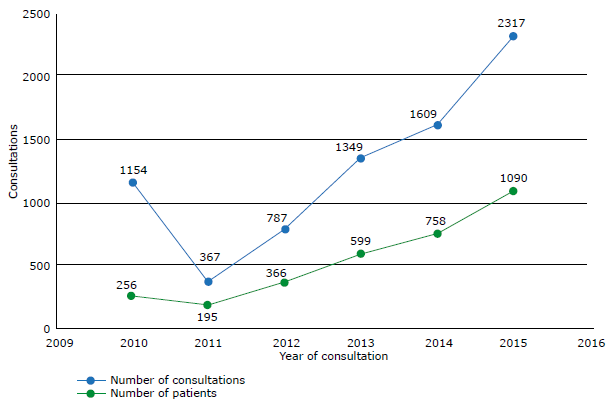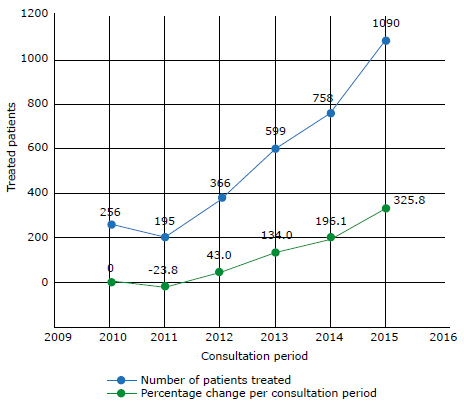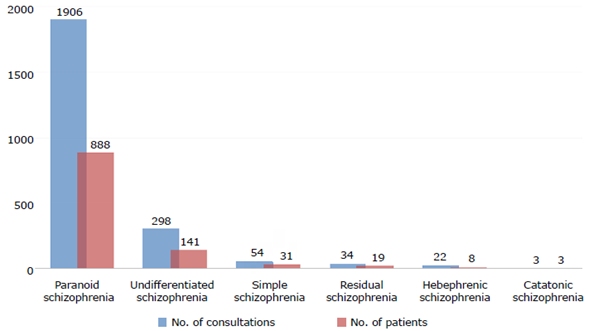Introduction
Schizophrenia is a mental disorder with symptoms that could be classified as positive or negative, which vary in intensity over time and cause, on the one hand, deterioration in work and social performance and interpersonal relationships, and, on the other, distortion of thinking, perception, and emotions. Consciousness and intellectual capacity are preserved, although schizophrenic patients may experience cognitive deficits over time.1 The term schizophrenia, which translates as "splitting mind," was introduced by Eugen Bleuer to explain the cognitive alterations described above as a splitting of mental processes.2
The annual prevalence of schizophrenia ranges between 2.7 and 8.3 cases per 1 000 inhabitants worldwide, with an annual incidence of 0.20 cases per 1 000 inhabitants. This condition affects men and women almost equally (1.4:1), but more often in the lower social classes, with a varied age of onset depending on the patient's sex (men: 15-25 years old and 25-35 years old).
Suicide has been identified as the leading cause of premature death among schizophrenic people considering that between 20% and 50% of this population attempt suicide, and between 10% and 13% consume it3. In Colombia, the Ministry of Health and Social Protection reported that the prevalence of schizophrenia in 2013 was 1%, resulting in an estimate of 471 052 people suffering from the disease in the country at the time.4 According to the Medellín Ciudad Saludable (Medellín Healthy City) Epidemiological Bulletin, in 2014, 4 608 individual emergency service records were associated with mental and behavioral disorders, of which 13.37% were caused by schizophrenia, schizotypal disorders and delirium.5
In 2010, Peñaloza-Quitero et al.6 published a report on the estimation of the burden of disease in Colombia, finding that neuropsychiatric problems, such as major depression, bipolar disorders, schizophrenia and epilepsy, account for 21% of the overall burden of years lost due to illness per thousand people. In turn, Benavides-Portilla et al.7 reported that the prevalence of this condition in cities such as Cali is estimated to be 1.5%, which is higher than the world average.
Despite the above, data on schizophrenia in Colombia are scarce and there is no detailed information on important areas of the country such as the department of Caldas, which is in the Andean region, and has an area of 7 888km2 and a population of about 923 000 people, according to the 2018 National Population and Housing Census.8 Considering this situation, the objectives of this study were to determine the prevalence and incidence of schizophrenia in Caldas between 2010 and 2015 and to describe its epidemiological profile in this area.
Materials and methods
Retrospective and descriptive study. The analysis included information on the number of patients treated and the number of consultations performed by psychiatrists in Caldas between 2010 and 2015, in which the diagnosis or reason for consultation was related to the following diagnostic codes of schizophrenia of the 10th International Classification of Diseases (ICD 10): F20.0: paranoid schizophrenia, F20.1-hebephrenic schizophrenia, F20.2-catatonic schizophrenia F20.3-undifferentiated schizophrenia, F20.6-residual schizophrenia and F20.5-simple schizophrenia. Diagnoses registered as "psychosis" were not included.
Data were obtained from the Territorial Health Management Office of Caldas and the Individual Health Service Provision Records of the Colombian Ministry of Health and Social Protection and were classified according to the municipalities of the department.
The numerical and categorical variables analyzed were number of patients, number of consultations, diagnosis, and year of consultation. With regard to descriptive analysis, data were presented using means, absolute frequencies and percentages. The annual prevalence rates of schizophrenia were calculated using the total number of consultations per year, while the annual incidence rates were obtained based on the number of new cases included in consultation each year. The distribution of data in numerical variables was determined with the Kolmogor-ov-Smirnov test, and the Mann-Whitney U test was used to compare the number of consultations and the number of patients treated depending on the type of schizophrenia. Statistical analyzes were performed in the Statistical Package for Social Sciences (SPSS®) version 24 and a significance level of p (α) <0.05 was considered.
The present study did not require the approval of the ethics committee because a secondary analysis of data was done; nonetheless, the data provided herein was anonymized to safeguard the patients' identities.
Results
Between 2010 and 2015, 3 264 patients attended 7 583 consultations for schizophrenia in Caldas, which resulted in a consultation-patient ratio of 2:1. During these consultations, paranoid, hebephrenic, catatonic, undifferentiated, residual, and simple schizophrenia were diagnosed. The prevalence of schizophrenia in the study population increased significantly in the study period from 0.03% in 2010 to 0.11% in 2015. Similarly, the cumulative incidence showed a marked upward trend, with 834 new cases of schizophrenia reported between 2010 and 2015 (Tables 1 and 2).
Table 1 Prevalence rates of schizophrenia in the department of Caldas, Colombia. 2010-2015.
| Year | Number of patients treated (n) | Prevalence for the period (total population) | Prevalence in patients over 18 years of age (45% of the population) | Population projection according to DANE |
|---|---|---|---|---|
| 2010 | 256 | 0.03% | 0.06% | 978 362 |
| 2011 | 195 | 0.02% | 0.04% | 980 281 |
| 2012 | 366 | 0.04% | 0.08% | 982 202 |
| 2013 | 599 | 0.06% | 0.14% | 984 128 |
| 2014 | 758 | 0.08% | 0.17% | 986 061 |
| 2015 | 1 090 | 0.11% | 0.25% | 988 003 |
DANE: Departamento Administrativo Nacional de Estadística (National Administrative Department of Statistics).
Source: Own elaboration.
Table 2 Cumulative incidence of schizophrenia in the department of Caldas, Colombia. 2010-2015.
| Year | Number of patients treated (n) | New cases per year of care | Cumulative incidence in patients over 18 years of age (45% of the population) |
|---|---|---|---|
| 2010 | 256 | 0 | 0 |
| 2011 | 195 | -61 | -0.0001 |
| 2012 | 366 | 171 | 0.0004 |
| 2013 | 599 | 233 | 0.0005 |
| 2014 | 758 | 159 | 0.0004 |
| 2015 | 1 090 | 332 | 0.0007 |
Source: Own elaboration.
Based on the analysis of the data, it was found that by 112.5% (Figures 1 and 2 and Table 3). The aver-both the number of consultations and the number of pa- age number of consultations and the average number tients treated increased progressively during the studied of patients treated were 210.6 and 90.7, respectively, period: the former increased by 101%, and the latter for the whole period under investigation.

Source: Own elaboration.
Figure 1 Chronological progression of the number of consultations and patients diagnosed with schizophrenia treated in the department of Caldas, Colombia. 2010-2015.

Source: Own elaboration.
Figure 2 Number of cases of schizophrenia treated and percentage change in the care provided to these patients in the department of Caldas, Colombia in the period 2010-2015.
Table 3 Evolution in the care process of patients diagnosed with schizophrenia in the department of Caldas, Colombia. 2010-2015.
| Year | Number of patients treated (n) | Percentage change per period of care |
|---|---|---|
| 2010 | 256 | 0 |
| 2011 | 195 | -23.8 |
| 2012 | 366 | 43.0 |
| 2013 | 599 | 134.0 |
| 2014 | 758 | 196.1 |
| 2015 | 1 090 | 325.8 |
Source: Own elaboration.
The most frequent type of schizophrenia was paranoid, which was reported in 5 051 consultations and 2 250 patients (ratio 2:1). The diagnostic grouping of the other types of schizophrenia showed a total of 2 532 consultations and 454 patients treated (ratio 6:1) (Table 4). Figure 3 shows the distribution of the care process in 2015.
Table 4 Number of consultations according to the type of schizophrenia in the department of Caldas, Colombia. 2010-2015.
| Consultations | Paranoid | Other types of schizophrenia | ||||
|---|---|---|---|---|---|---|
| Undifferentiated | Simple | Residual | Hebephrenic | Catatonic | ||
| Number of consultations | 5 051 | 1 584 | 452 | 422 | 42 | 32 |
| Number of patients treated | 2 250 | 560 | 203 | 207 | 20 | 24 |
Source: Own elaboration.

Source: Own elaboration.
Figure 3 Number of consultations and patients treated in 2015 according to the type of schizophrenia in the department of Caldas, Colombia (total consultations: 2 317, total treated: 1 090).
The Kolmogorov-Smirnov test with Lilliefors correction revealed that the numerical variables collected had a non-normal distribution (p=0.000). In addition, the Mann-Whitney U test found a statistically significant difference between the number of consultations and the number of patients treated in relation to the diagnostic categories 'paranoid schizophrenia' and 'other types of schizophrenia' (diagnostic dichotomization; p=0.000).
Discussion
The incidence of a disease refers to the occurrence of new cases in a population over a period of time.9 In the case of schizophrenia, and many other diseases, incidence can also be estimated in subgroups of the general population; for example, a measurement can be made taking into account the year in which people are born, which is useful when looking for a possible correlation between age and onset of the disease.
Therefore, some studies have determined the incidence of schizophrenia considering geographical areas over specific periods, while others have done so in subpopulations, differentiating for example men from women or specifying social status, such as research conducted on immigrants, in people of certain religions or ethnic groups, in people with special characteristics, in persons over 65 years of age, or in individuals with other conditions.
The incidence of schizophrenia found in this study for the department of Caldas, which by 2015 reached 70 cases per 100 000 inhabitants, is much higher than that reported by McGrath et al.,10 who, in a systematic review of this disease, analyzed 158 studies involving 32 countries and established an average annual incidence of 15.2 cases per 100 000 inhabitants. These authors also found that the figures are higher in developed countries, where incidence ranges from 7.7 to 43 cases per 100 000 inhabitants.
It should be noted that the diagnostic method of schizophrenia directly influences the incidence values obtained. This was reported by Jablensky et al.11 in their study, in which they found figures between 0-7 and 1-4 cases per 100 000 inhabitants when the CATEGO class S+ scale was used and between 1-5 and 4-2 cases per 100 000 inhabitants when the 9th International Classification of Diseases was used.
Likewise, it is essential to stress, as confirmed by studies covering large populations,12-14 that schizophrenia has similar incidence rates among different populations, with higher numbers in men than in women,15 and in urban areas than in rural areas.16 Furthermore, it has been found that the incidence of this disease is higher in immigrants,17,18 although authors such as McGrath et al.19 believe otherwise. In the present study, only the diagnosis of schizophrenia was considered and no analysis was carried out on the basis of the rural or urban origin of the population or the sex of the patients. However, it is noteworthy that, in general terms, there was a large increase in the number of cases of schizophrenia diagnosed during the analyzed period.
On the other hand, it is important to bear in mind that, as Torrey reported20 in an article for which he reviewed more than 70 studies on the prevalence of schizophrenia, there may be significant differences in the number of cases of this disease among different populations and that this number can also change over time. This was confirmed by Saha et al.,21 who, through a literature review, analyzed the prevalence of schizophrenia in 46 countries using 188 studies published between 1965 and 2002. They found that even though there is substantial variation among the sites evaluated, it usually varies from 4 to 7 cases per 1 000 inhabitants depending on the measurement method used; these authors also found that developing countries have a lower prevalence of the disease and that it does not vary between sexes.22 In the present study, the prevalence of schizophrenia was 0.03% in 2010, reaching 0.11% in 2015.
The increases in prevalence and incidence found in the present study may be explained by several related factors such as increased stress burden, unemployment, social exclusion, etc., which are common in Colombia and may become epigenetic phenomena that contribute to the development of mental illnesses.
Another critical factor that could have influenced the increased incidence and prevalence of schizophrenia in this study is access to drugs such as olanzapine and risperidone. These drugs were included in the mandatory health plan for the treatment of this disease through Resolution 5521 of 2013 of the Ministry of Health and Social Protection,23 but physicians may include patients with other mental disorders within the group of patients diagnosed with schizophrenia to prescribe them based on the principle of beneficence. This practice, known as "off-label use," consists of prescribing drugs for conditions that are not contemplated in their technical data sheet or for uses that are not approved by regulatory agencies, reaching up to 11% of all prescriptions in the U.S., 21% in Canada, and 40% in Australia.24
Finally, a limitation of the study is a possible information bias since the data were obtained based on the care process and not for research purposes, a situation that limits the study's capacity to have control over the original collection of the data.
Conclusion
The marked increase in the prevalence and incidence of schizophrenia in Caldas during the study period may be explained by several factors, so it is necessary to review its epidemiological profile in other departments of the country and confirm whether this increase is also observed at the national level. This is a first step to try to identify the factors associated with its occurrence in the Colombian population.















